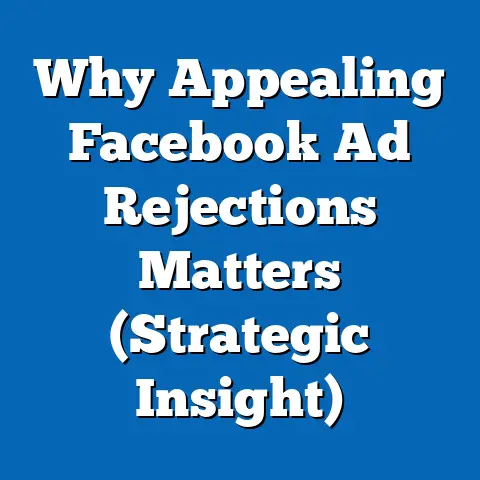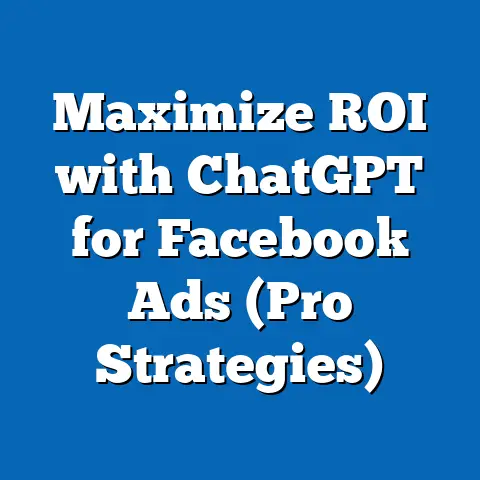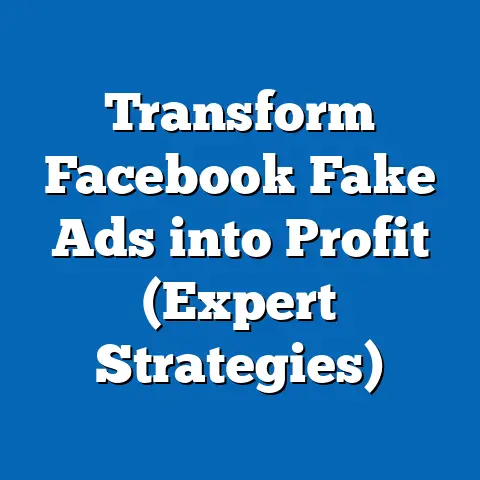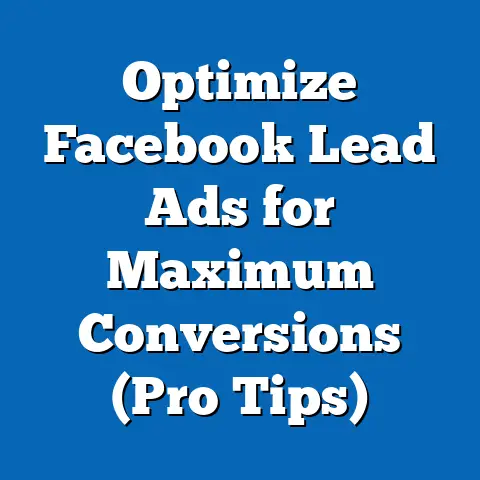Maximize ROI with Expert Facebook Ads (Pro Strategies)
Did you know that businesses can see an average return of $8.71 for every $1 spent on Facebook ads? As a digital marketing specialist, I’ve seen firsthand how Facebook advertising can be a game-changer for businesses of all sizes. But the key to unlocking that potential lies in understanding and implementing expert strategies. In this article, I’ll share my insights and experiences to help you maximize your ROI with Facebook ads.
Understanding Facebook Ads and ROI
Return on Investment, or ROI, is the compass that guides every successful marketing campaign. In the context of Facebook advertising, ROI is the measure of profit you generate for every dollar you invest in your ads. It’s not just about making sales; it’s about understanding whether your advertising dollars are working efficiently to achieve your business goals.
Why is measuring ROI so crucial? Well, imagine sailing a ship without a navigational system. You might be moving, but are you headed in the right direction? Measuring ROI provides clear insights into which ads are performing well, which audiences are most receptive, and which strategies are yielding the best results. Without this data, you’re essentially flying blind, wasting valuable resources on ineffective campaigns.
Facebook ads offer a unique set of advantages that can lead to significant ROI when used strategically. First, the platform boasts an unparalleled audience reach. With billions of active users worldwide, Facebook provides access to a diverse and engaged audience. Second, Facebook’s advanced targeting capabilities allow you to pinpoint your ideal customers based on demographics, interests, behaviors, and more. This precision targeting ensures that your ads are seen by the people most likely to convert. Finally, Facebook offers a variety of ad formats, from simple image ads to engaging video ads and interactive carousel ads, allowing you to tailor your messaging to different audience segments and campaign objectives.
Key Takeaway: Understanding ROI and leveraging Facebook’s unique advantages are the foundation for successful advertising.
Setting Clear Objectives
Before you even think about creating an ad, you need to define what you want to achieve. Are you looking to increase brand awareness, generate leads, drive sales, or something else entirely? Setting clear, measurable objectives is crucial because it dictates every aspect of your campaign, from targeting and ad creative to budget allocation and performance metrics.
For example, if your goal is to increase brand awareness, you might focus on reaching a broad audience with engaging content and measuring metrics like reach, impressions, and engagement rate. On the other hand, if your goal is to generate leads, you’ll need to target a more specific audience with compelling offers and measure metrics like click-through rate (CTR), conversion rate, and cost per lead (CPL).
I’ve seen firsthand how specific goals lead to tailored ad strategies. For instance, I once worked with a local bakery that wanted to increase online orders. Instead of simply running generic ads, we created a campaign specifically targeting people interested in desserts and special occasions within a 5-mile radius of the bakery. We used mouth-watering visuals of their cakes and pastries, along with a compelling offer for a discount on first-time orders. As a result, we saw a significant increase in online orders and a substantial return on their ad spend.
Key Takeaway: Define clear, measurable objectives before launching your campaign to ensure that your ad strategies are aligned with your business goals.
Audience Targeting Strategies
One of the most powerful features of Facebook advertising is its ability to target specific audiences based on a wide range of criteria. While basic targeting options like demographics and interests are useful, advanced targeting strategies can take your ad performance to the next level.
Creating buyer personas is an essential step in understanding your target audience. A buyer persona is a semi-fictional representation of your ideal customer, based on research and data about your existing customers. By creating detailed buyer personas, you can gain insights into their demographics, interests, behaviors, pain points, and motivations. This information can then be used to refine your targeting and create more relevant and engaging ad creatives.
Segmenting your audience effectively is also crucial. Not all customers are created equal, and you need to tailor your messaging to different segments based on their unique characteristics. For example, you might segment your audience based on age, gender, location, interests, or past purchase behavior. By creating targeted ads for each segment, you can increase engagement and conversion rates.
Facebook’s Custom Audiences and Lookalike Audiences are powerful tools for reaching the right people. Custom Audiences allow you to target people who have already interacted with your business, such as website visitors, email subscribers, or customers. Lookalike Audiences allow you to reach new people who are similar to your existing customers, based on shared characteristics and behaviors.
I remember working with an e-commerce client who was struggling to generate sales. By using Custom Audiences to retarget website visitors who had abandoned their shopping carts, we were able to recover a significant percentage of lost sales. We also created Lookalike Audiences based on their existing customers, which allowed us to reach new potential customers who were highly likely to convert.
Leveraging Facebook Insights is another essential step in refining your targeting. Facebook Insights provides valuable data about your audience, including their demographics, interests, behaviors, and ad engagement. By analyzing this data, you can gain insights into what resonates with your audience and optimize your targeting accordingly.
Key Takeaway: Advanced targeting strategies like creating buyer personas, segmenting audiences, and leveraging Custom and Lookalike Audiences can significantly enhance your ad performance and ROI.
Crafting Compelling Ad Creatives
Your ad creative is the first thing people see, so it needs to be attention-grabbing, relevant, and persuasive. High-performing ad creatives typically include compelling visuals, engaging copy, and clear calls-to-action (CTAs).
Visuals are crucial for capturing attention and conveying your message quickly. Use high-quality images or videos that are relevant to your target audience and campaign objective. Consider using bright colors, eye-catching graphics, and human faces to increase engagement.
The ad copy should be concise, clear, and persuasive. Highlight the benefits of your product or service, and address the pain points of your target audience. Use strong verbs and persuasive language to encourage action.
CTAs tell people what you want them to do next. Use clear and specific CTAs like “Shop Now,” “Learn More,” “Sign Up,” or “Get Started.” Make sure your CTA is prominently displayed and easy to click.
Storytelling can also enhance engagement and retention. People are naturally drawn to stories, so consider incorporating storytelling elements into your ad creatives. Tell a story about how your product or service has helped others, or share a personal anecdote that resonates with your target audience.
I’ve seen countless examples of successful ad creatives that have driven significant results. One that stands out is a video ad for a local gym. The ad featured real members sharing their personal success stories, highlighting the positive impact the gym had on their lives. The ad was authentic, relatable, and emotionally engaging, which led to a significant increase in gym memberships.
Key Takeaway: Crafting compelling ad creatives with engaging visuals, persuasive copy, and clear CTAs is essential for capturing attention and driving results.
A/B Testing and Optimization
A/B testing, also known as split testing, is the process of comparing two versions of an ad to see which one performs better. It’s a crucial step in maximizing ROI because it allows you to identify the most effective ad elements and optimize your campaigns for better results.
The process for conducting A/B tests involves creating two versions of an ad that are identical except for one element. This element could be the headline, image, copy, CTA, or target audience. Run both ads simultaneously and track their performance over a set period. Then, analyze the results to see which ad performed better based on your chosen metrics.
I recommend testing different ad elements systematically to identify what resonates most with your audience. For example, you could test different headlines to see which one generates the highest click-through rate. You could also test different images to see which one captures the most attention.
Analyzing test results and implementing changes based on data insights is crucial. Once you’ve gathered enough data, analyze the results to see which ad performed better. Use this information to make changes to your ad campaigns and optimize them for better results.
Key Takeaway: A/B testing is a crucial step in maximizing ROI because it allows you to identify the most effective ad elements and optimize your campaigns for better results.
Budgeting and Bidding Strategies
Setting an appropriate budget for Facebook ads is essential for maximizing ROI. Your budget should be based on your campaign objectives, target audience, and the value of each conversion.
Different campaign objectives require different budgets. For example, a brand awareness campaign might require a larger budget to reach a broad audience, while a lead generation campaign might require a smaller budget to target a more specific audience.
Facebook offers a variety of bidding strategies, including manual bidding and automatic bidding. Manual bidding allows you to set the maximum amount you’re willing to pay for each click or impression, while automatic bidding allows Facebook to optimize your bids for the best possible results.
I’ve found that it’s often best to start with automatic bidding and then switch to manual bidding once you have enough data to optimize your bids effectively.
Allocating your budget effectively across different campaigns or ad sets is also crucial. Consider allocating more budget to campaigns or ad sets that are performing well and less budget to those that are not.
Key Takeaway: Setting an appropriate budget and choosing the right bidding strategy can significantly impact your ad delivery, performance, and ROI.
Utilizing Retargeting Strategies
Retargeting is the process of showing ads to people who have already interacted with your business, such as website visitors, email subscribers, or customers. It’s a powerful strategy for enhancing ROI because it allows you to re-engage potential customers who have already shown interest in your products or services.
Setting up retargeting campaigns using Facebook Pixel is relatively straightforward. The Facebook Pixel is a piece of code that you place on your website to track visitor behavior. Once the pixel is installed, you can create Custom Audiences based on specific actions visitors take on your website, such as viewing a product page, adding an item to their cart, or abandoning their shopping cart.
Effective retargeting strategies include showing ads for products that visitors viewed on your website, offering discounts or promotions to encourage them to complete their purchase, or providing helpful information or resources related to their interests.
Key Takeaway: Retargeting is a powerful strategy for enhancing ROI because it allows you to re-engage potential customers who have already shown interest in your products or services.
Leveraging Analytics and Reporting
Monitoring ad performance through Facebook Ads Manager is essential for understanding what’s working and what’s not. Facebook Ads Manager provides a wealth of data about your campaigns, including reach, impressions, clicks, conversions, and cost per conversion.
Key performance indicators (KPIs) that marketers should focus on include click-through rate (CTR), conversion rate, cost per acquisition (CPA), and return on ad spend (ROAS). CTR measures the percentage of people who click on your ad after seeing it. Conversion rate measures the percentage of people who complete a desired action, such as making a purchase or filling out a form. CPA measures the cost of acquiring a new customer. ROAS measures the revenue generated for every dollar spent on advertising.
Generating reports and analyzing data to inform future ad strategies is crucial. Use the data from Facebook Ads Manager to identify trends, patterns, and areas for improvement. Then, use this information to optimize your campaigns and improve your ROI.
Key Takeaway: Monitoring ad performance through Facebook Ads Manager and analyzing data to inform future ad strategies is crucial for maximizing ROI.
Staying Updated with Facebook’s Algorithm Changes
Facebook’s advertising platform and algorithm are constantly evolving, which means that what worked yesterday might not work today. Staying informed about updates and changes is crucial for maximizing ROI.
I recommend subscribing to industry blogs, attending webinars, and following social media influencers who specialize in Facebook advertising. This will help you stay up-to-date on the latest trends and best practices.
Key Takeaway: Staying updated with Facebook’s algorithm changes is crucial for maximizing ROI.
Conclusion
Maximizing ROI with Facebook ads requires a strategic, data-driven approach. By setting clear objectives, targeting the right audience, crafting compelling ad creatives, A/B testing and optimizing your campaigns, managing your budget effectively, utilizing retargeting strategies, leveraging analytics and reporting, and staying updated with Facebook’s algorithm changes, you can unlock the full potential of Facebook advertising and achieve significant results.
I encourage you to implement these expert strategies in your next Facebook ad campaign and see the difference they can make. Remember, Facebook advertising is an ongoing process of experimentation and optimization, so don’t be afraid to try new things and learn from your mistakes. With the right approach, you can achieve a significant return on your investment and drive meaningful results for your business.






